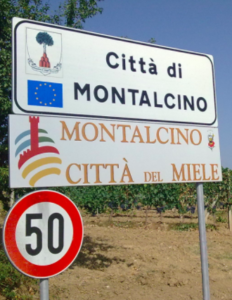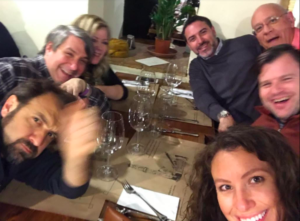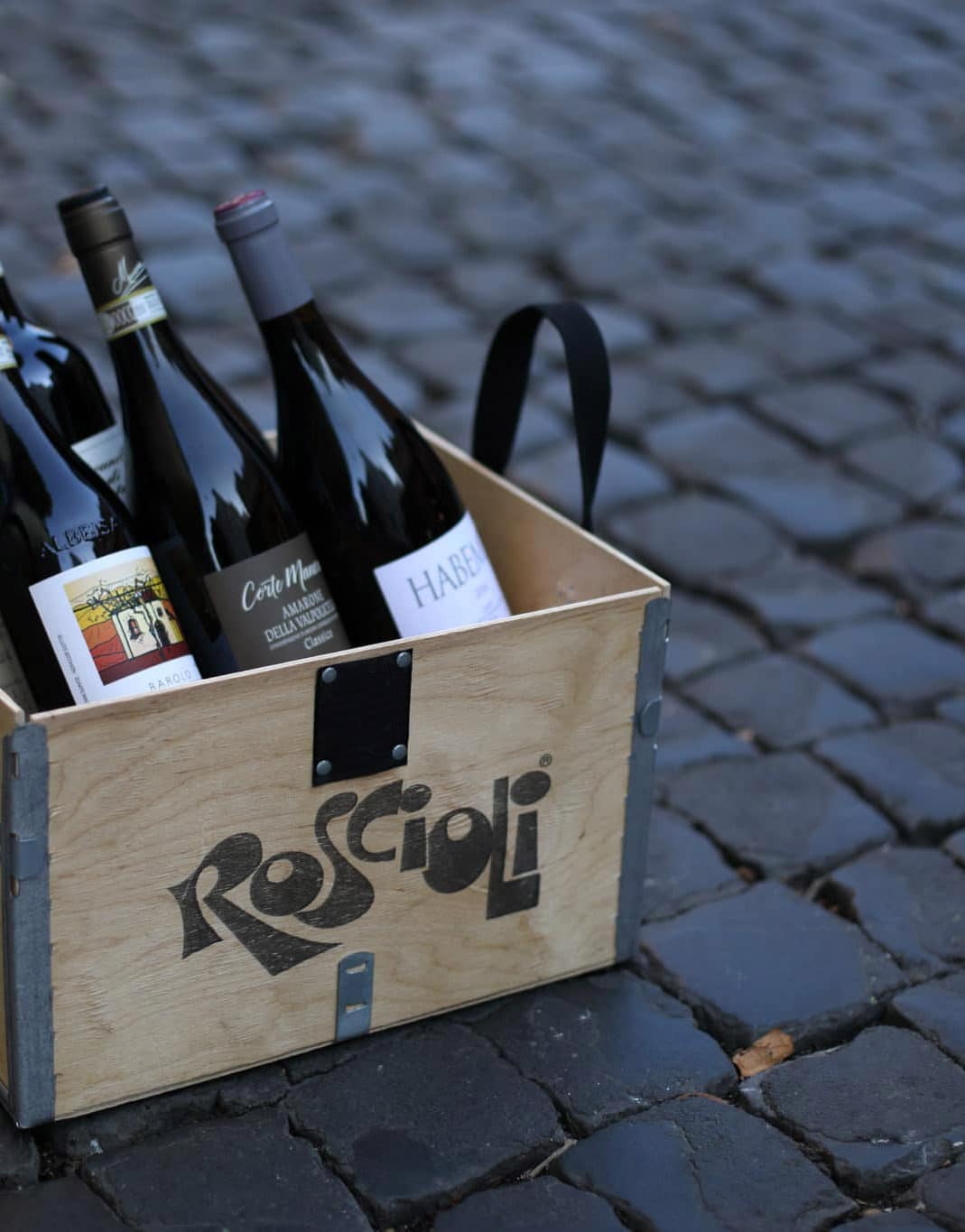Two months back in the US and I left feeling full on friends, family and familiarity but craving what I love so much about my life in Italy—the spirit of Rimessa Roscioli, the real flavors in the food and wine, the extensive culture and diversity from village to village, the immense history, the richness of life here. Ironically I was welcomed back to the Rimessa by 2 clients that we had met in Santa Barbara just a month before, followed by a beautiful night of 8 “Rimessa” friends sharing and opening 12 bottles together, and then it was up to Montalcino for the Benvenuto Brunello wine festival.
Benvenuto a Montalcino – City of honey?
Numbers and data can paint the story pretty well here. Montalcino in 1968 (just before it is awarded DOC status): 11 producers, producing around 250,000 bottles from 76 hectares of land. By 1980 when it was awarded DOCG status, it had ballooned to 53 producers. Montalcino today has 250  producers sprawling over 2,500 hectares, producing more than 8 million bottles – which all seems a bit scary to me. So what happened? Without mentioning names, in came an Italian-American family, inspired by the legendary wines of Biondi-Santi, with plenty of cash from their success making the infamous Riunite Lambrusco (that red sparking wine that is so sweet it makes your teeth hurt). They would change this region through heavy promotion in the U.S., while others around the area decided to capitalize on this opportunity as well. Their production now is somewhere around a modest 8 million bottles of year, much of which is destined for you to purchase in the US. So what’s the problem? The initial area where Brunello found its success was quite small and the soils and terroir vary greatly in today’s DOCG, meaning quality varies greatly here as well. And when a region becomes a brand, and a brand signifies consistency, and the wines are anything but, it can be troubling to the consumer. Some have suggested sub-dividing the region to better understand what to expect from the wine, but unfortunately the messy politics of the matter have prevented that from happening.
producers sprawling over 2,500 hectares, producing more than 8 million bottles – which all seems a bit scary to me. So what happened? Without mentioning names, in came an Italian-American family, inspired by the legendary wines of Biondi-Santi, with plenty of cash from their success making the infamous Riunite Lambrusco (that red sparking wine that is so sweet it makes your teeth hurt). They would change this region through heavy promotion in the U.S., while others around the area decided to capitalize on this opportunity as well. Their production now is somewhere around a modest 8 million bottles of year, much of which is destined for you to purchase in the US. So what’s the problem? The initial area where Brunello found its success was quite small and the soils and terroir vary greatly in today’s DOCG, meaning quality varies greatly here as well. And when a region becomes a brand, and a brand signifies consistency, and the wines are anything but, it can be troubling to the consumer. Some have suggested sub-dividing the region to better understand what to expect from the wine, but unfortunately the messy politics of the matter have prevented that from happening.
That said, while at Benvenuto, my palate had no trouble discerning a common group of exceptional Brunellos, many of which were coming from one particular hill, Montosoli.
The majestic Montosoli Cru
Biondi-Santi aside, most of my favorite wines were coming from a 15 hectare hill, farmed by 5 producers – Le Ragnaie, Baricci, Pietroso, Altesino, and Caparzo. What makes it so special? A unique exposure at 270-450m, receiving an abundance of sun, yet cooler temperatures moderated by the Montalcino hill and fresh breezes – which are special to this northern part of Montalcino. There’s also diverse soil comprised of shale, marl, quartz and clay (galestro), amalgamated into a paste with marine components, derived from the Pliocene era, which has excellent drainage in wet years. All of these components give the grapes the ability to make powerful yet elegant, complex and rich wines which are beautifully persistent on the palate.
Maybe these producers owe a thank you to these bigger companies who have helped expose this region to the world, but regardless, this hill has been achieving its award-winning fame even 2 centuries earlier, according to the grandfather of Francesco Buffi of Baricci.
Overall, even beyond the wines of Montosoli, I was quite impressed by the Brunello di Montalcino at Benvenuto this year (mainly from the 2013 vintage). The wines were quite refreshing with seemingly great aging potential, and less presence of oak. That said, skip the mass production wines of the area which lack any sense of aliveness on the palate and caused me immediately to sneeze, and go for the smaller producers or ones that have some elevation. But this is a vintage that definitely warrants putting a few bottles in the cellar.
Local pairings
If y ou come to Montalcino, definitely enjoy la cucina povera (country food) while here. Great examples are Pappa al pomodoro, a soup made from bread, tomatoes, and olive oil or panzanella, another way to use leftover bread. A must try are the pici, also known as ‘pinci’ in Montalcino (someone told me it’s because they couldn’t pronounce it
ou come to Montalcino, definitely enjoy la cucina povera (country food) while here. Great examples are Pappa al pomodoro, a soup made from bread, tomatoes, and olive oil or panzanella, another way to use leftover bread. A must try are the pici, also known as ‘pinci’ in Montalcino (someone told me it’s because they couldn’t pronounce it properly here), which is the local handmade noodle with a pencil thickness, often accompanied by a ragù, aglione ‘tomato garlic’ or cacio e pepe sauce. Then there is the obvious Fiorentina steak, which paired excellent with the local wines. I might say skip the ribollita in Montalcino, as it is a traditional plate of Florence. I was disappointed in varying degrees the 3 times we ordered it.
properly here), which is the local handmade noodle with a pencil thickness, often accompanied by a ragù, aglione ‘tomato garlic’ or cacio e pepe sauce. Then there is the obvious Fiorentina steak, which paired excellent with the local wines. I might say skip the ribollita in Montalcino, as it is a traditional plate of Florence. I was disappointed in varying degrees the 3 times we ordered it.
The best things in life are shared
And I’ll conclude with the idea that we love to spread at the Rimessa – sharing. All of this weekend was extra special because all the memories were shared with friends, and we’ll always have this weekend of indulging and splurging to reminisce together about. Over 3 days, I think we split somewhere around 18 bottles of wine ranging from a 300 euro 1998 Mouton-Rothschild, to a 150 euro bottle of 1995 Vega Sicilia Valbuena 5 (exceptional!), Brunello, Barolo, Champagne etc… Dividing these bottles by 6-8 people made them all more accessible, affordable and more enjoyable, and left us in beautiful conversation and debates which will surely ensue in the cellar of Rimessa the next time we all get together.


 SEI IN ITALIA? CLICCA QUI
SEI IN ITALIA? CLICCA QUI 

